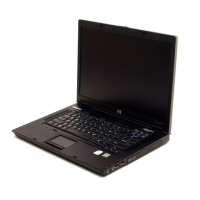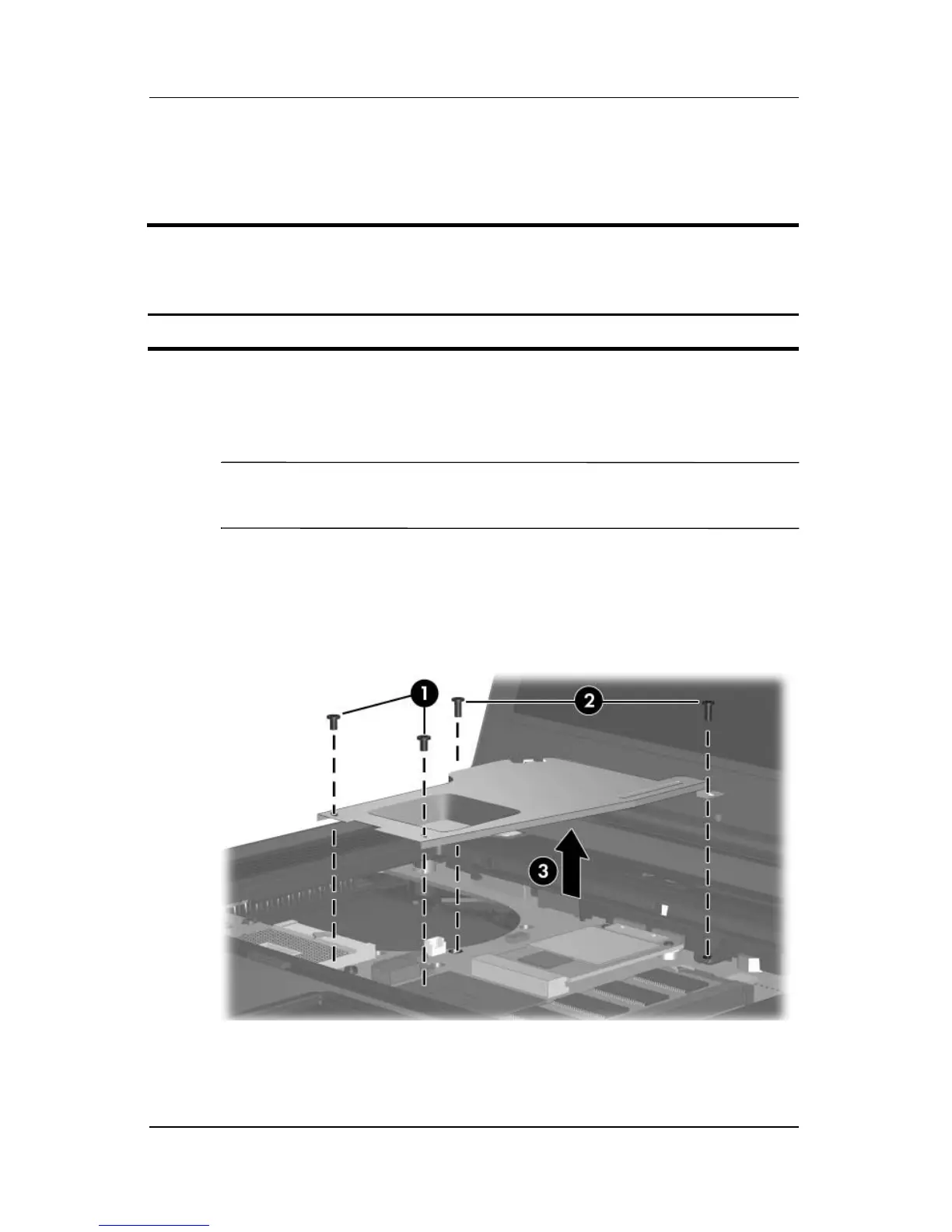

Do you have a question about the HP Compaq NX7300 and is the answer not in the manual?
| Graphics | Intel Graphics Media Accelerator 950 |
|---|---|
| Operating System | Windows XP Professional |
| Wireless | 802.11a/b/g |
| RAM | 512 MB DDR2 SDRAM |
| Storage | 80GB or 120GB HDD |
| Display | 15.4 inch WXGA (1280x800) |
| Optical Drive | DVD-ROM |
| LAN | 10/100/1000 Ethernet |
| Ports | 3 x USB 2.0, VGA, RJ-11, RJ-45, headphone, microphone |
| Battery | 6-cell Lithium-Ion |
| Weight | 2.7 kg |
Details the various processors and display options available for the computer models.
Provides steps to reset the computer's BIOS settings and clear CMOS passwords.
Lists the power management features supported by the computer for extending battery life.
Identifies and describes the external components on the front, right, rear, and left sides of the computer.
Presents a system board overview and device connections, including ventilation precautions.
Explains how to access and navigate the computer's BIOS setup utility.
Details the procedure for returning all Computer Setup settings to their factory defaults.
Provides an overview of the File menu options within Computer Setup.
Details the options available in the Security menu for password and drive lock settings.
Outlines the diagnostic tests available for hard drives and system memory.
Explains various system configuration options for devices, boot order, and ports.
Provides an overview of troubleshooting flowcharts for common computer issues.
Indicates where to find the computer's serial number on the bottom panel.
Illustrates the major internal components of the computer with corresponding part numbers.
Lists the components included in the plastics kit and their spare part numbers.
Details spare part information for hard drives and optical drives.
Lists spare parts for miscellaneous items like AC adapters, docking stations, and carrying cases.
Provides a comprehensive list of spare parts and their corresponding part numbers.
Lists the necessary tools for performing removal and replacement procedures.
Provides general considerations and cautions for disassembly and reassembly procedures.
Offers precautions to prevent damage when handling removable drives.
Explains the risks of electrostatic discharge (ESD) and how to prevent it.
Details precautions for packaging and transporting equipment safely.
Outlines grounding precautions and best practices for working at workstations.
Describes essential grounding equipment and methods for preventing static damage.
Explains the importance of reporting the computer's serial number for service requests.
Provides a chart to determine the section number for removing computer components.
Lists the essential steps to take before starting any removal or installation procedures.
Details the procedure for removing and replacing the computer's hard drive.
Describes how to replace the adhesive-backed rubber computer feet.
Provides instructions for removing and replacing the optical drive.
Guides the user through removing and installing external memory modules (RAM).
Details the procedure for removing and replacing the Bluetooth module.
Provides step-by-step instructions for keyboard removal and installation.
Explains the process for removing and installing the thermal plate.
Details the steps for removing and replacing the computer's fan assembly.
Provides instructions for removing and replacing the heat sink assembly.
Guides the user through the process of removing and installing the processor.
Details the procedure for removing and installing the Mini Card wireless module.
Provides instructions for removing and installing internal memory modules (RAM).
Explains how to remove and replace the Real-Time Clock (RTC) battery.
Details the steps for removing and replacing the switch cover assembly.
Provides instructions for removing and replacing the entire display assembly.
Guides the user through the procedure for removing and replacing the top cover.
Details the process for removing and installing the modem module.
Provides instructions for removing and replacing the system board.
Details the procedure for removing and replacing the system board frame.
Explains how to remove and replace the USB/Audio board.
Lists general physical and performance specifications for the computer.
Details specifications for the 15.4-inch WSXGA+ display.
Details specifications for the 15.4-inch WXGA+ display.
Lists specifications for various hard drive capacities (120-GB, 100-GB, 80-GB, 60-GB, 40-GB).
Specifies capabilities and dimensions for DVD±RW and CD-RW combo drives.
Details specifications for the DVD/CD-RW combo drive.
Lists specifications for the DVD-ROM drive.
Details the system DMA channel assignments and their functions.
Lists system interrupt requests (IRQs) and their associated hardware functions.
Provides a map of system I/O addresses and their shipping configuration functions.
Details the system memory map, including addresses and functions.
Details specifications and usage for Phillips PM3.0x3.0 screws.
Provides specifications and locations for Phillips PM2.0x5.0 captive screws.
Details specifications and locations for Phillips PM2.5x13.0 captive screws.
Details specifications and locations for Torx8 T8M2.5x4.0 screws.
Provides specifications and locations for Phillips PM2.0x3.0 screws.
Details specifications and locations for Phillips PM1.5x3.0 screws.
Details specifications and locations for Torx8 T8M2.5x10.0 screws.
Provides specifications and locations for Phillips PM2.5x3.0 screws.
Details specifications and locations for Phillips PM2.5x5.0 screws.
Provides specifications and locations for Phillips PM2.5x7.0 captive screws.
Details specifications and locations for Phillips PM2.0x8.0 captive screws.
Provides specifications and locations for Phillips PM2.0x4.0 screws.
Details specifications and locations for Phillips PM2.0x2.0 screws.
Provides specifications and locations for Phillips PM2.5x4.0 screws.
Details specifications and locations for Hex HM5.0x12.0 screw locks.
Provides specifications and locations for Torx8 T8M2.5x6.0 screws.
Provides guidance on when to perform backups for system information and files.
Offers tips and suggestions for effective backup and recovery procedures.
Explains how to back up individual files and folders to various storage locations.
Details the process of creating a full system backup, including OS and applications.
Guides the user on creating system recovery points for reverting to previous states.
Describes how to use HP Backup Scheduler for automated backup tasks.
Explains how to perform system recovery using backup data.
Outlines the steps for performing system recovery using created recovery discs.
Describes two methods for initiating system recovery directly from the hard drive.
Explains how to start a system recovery process while within the Windows operating system.
Details how to initiate system recovery from the dedicated hard drive recovery partition.
Provides guidelines and steps for creating system recovery discs for Windows XP.
Explains how to back up system files and information in Windows XP.
Offers tips for efficient backup procedures and saving customized settings.
Details how to back up individual files and folders in Windows XP.
Explains the process of creating a complete backup of the hard drive in Windows XP.
Guides on creating system recovery points for reverting changes in Windows XP.
Describes how to schedule automated backups for system and files in Windows XP.
Explains how to perform system recovery from backup data in Windows XP.
Details how to perform system recovery using created recovery discs in Windows XP.
Describes methods to initiate system recovery from the hard drive in Windows XP.
Explains how to start system recovery from within the Windows OS.
Details how to start system recovery from the hard drive's recovery partition.
Provides pin assignments for the 3.5mm audio-out (headphone) connector.
Provides pin assignments for the 3.5mm audio-in (microphone) connector.
Details the pin assignments for the Universal Serial Bus (USB) connector.
Provides pin assignments for the external monitor connector (VGA).
Details the pin assignments for the RJ-11 modem connector.
Provides pin assignments for the RJ-45 network connector.
Details the general requirements for 3-conductor power cord sets.
Lists general requirements applicable to power cord sets in all countries/regions.
Specifies country/region-specific requirements for power cord sets and agencies.